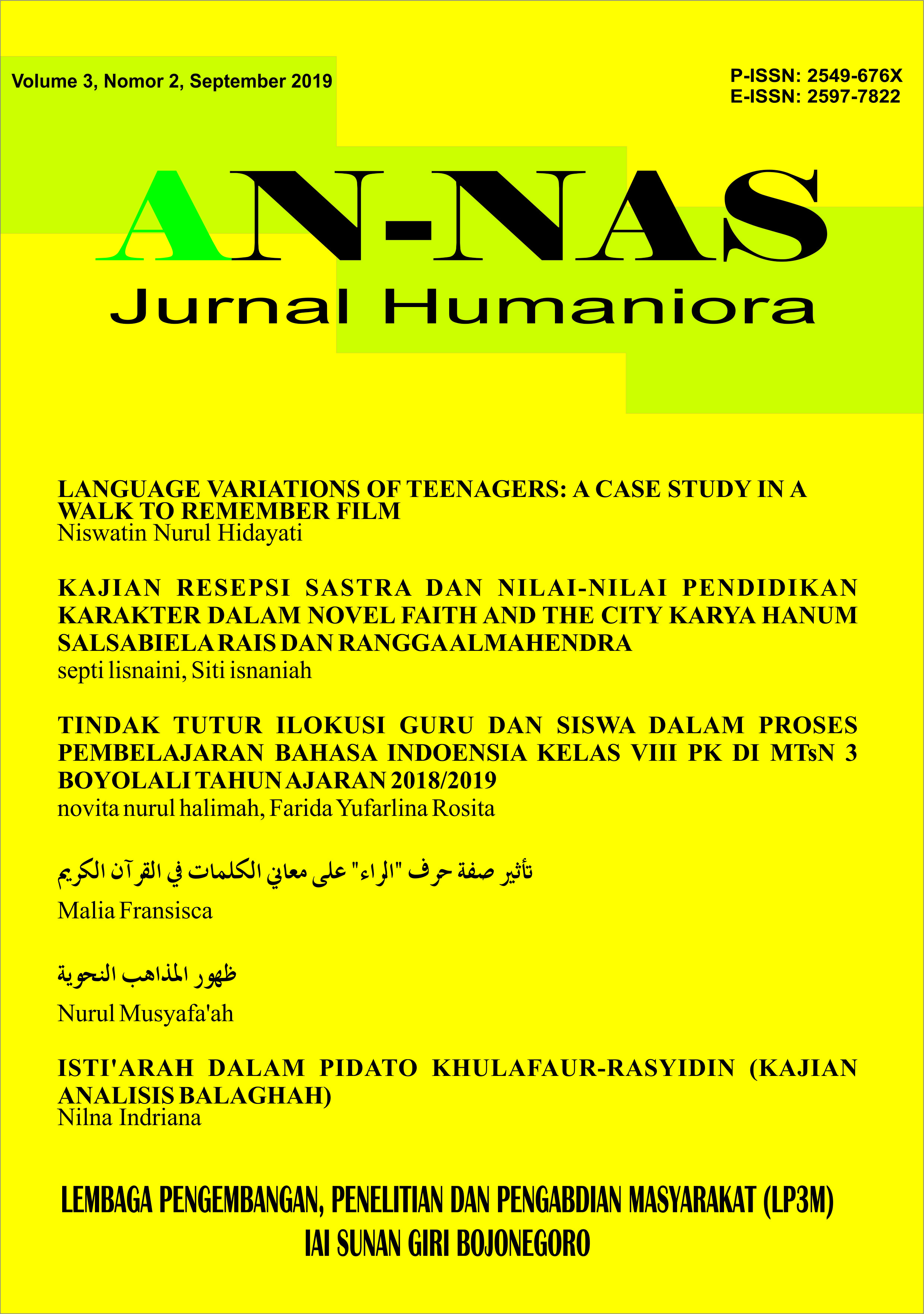ISTI’ARAH DALAM PIDATO KHULAFAUR-RASYIDIN (KAJIAN ANALISIS BALAGHAH)
 PDF Download: 4
PDF Download: 4
Keywords:
Metaphor, Speech, KhulafaurrasyidinAbstract
“This research is to analyze metaphor in the collection of
Khulafaurrasyidin’s speeches. Khulafaurrasyidin is a important figure of Islam
after propet Muhammad saw. pass away from this word. There are four of speeches
of Khulafaurrasyidin that delivered when they are become a caliph. This research
uses the theory of metaphor presented by Halley who classified metaphor into nine
types based on semantic field. The research nature is qualitative descriptive using
library research. This study describe the phenomenon of figurative language
metaphor related to the object of research. And finally, the research findings are
presented informally. Based on the research toward speeches of Khulafaurrasyidin,
researcher finds eight types of source domains metaphor. They are being, cosmos,
energy, terrestrial, object, living, animate and human. And four types of target
domains. The metaphors used tn the speeches show the corelation between
semantic methapor with Arab living and culture with the result that have many
different in number of quantity. And researcher also find a different and
characteristic of caliph delivery speeches. That different because of character,
culture and social politic condition in that period.”
References
Aminuddin. 2011. Semantik: Pengantar Studi tentang Makna. Bandung: Sinar Baru
Algensindo.
Arianto. 2013. Isti’arah (metafora) dalam puisi Imam Syafi’i. Tesis Tidak diterbitkan.
Program Pascasarjana Program Studi Linguistik Universitas Gadjah Mada.
Al-Jarim, Ali, dkk. Terjemahan Al-Balaghatul Wadhihah. Bandung: Sinar Baru Algensindo.
Brown, Douglas H. 2007. Prinsip Pembelajarandan Pengajaran Bahasa. Edisi Kelima.
United States: Pearson Education Inc.
Chaer, Abdul, 2012, Linguistik Umun, Jakarta : Rineka Cipta.
Cruse, D.A. 1986. Lexical Semantics. Cambridge: Cambridge University Press.
Haley, Michael C. 1980. Lingusitics Perspectives on Literature. London : Routladge and
Kegan Paul.
Hitti, K. Philip. 2002. History of the Arabs. Jakarta : Serambi Ilmu Semesta.
Kridalaksana, Harimurti. 2008. Kamus Linguistik, Edisi Keempat. Jakarta: Penerbit Gramedia
Pustaka Utama.
Khalid, Muh. Khalid. 2006. Khalifah Rasulullullah. Bandung : CV. Penerbit Diponegoro.
Kholas, Ahmad. 1995. Taisirul Balaghah. Jeddah : Maktabah Al-wabiq
Kridalaksana, Harimurti. 2005.Mongin Ferdinand De Saussure, Peletak Dasar Strukturalisme
Dan Linguistik Modern, EdisiPertama. Jakarta: Yayasan Obor Indonesia.
Keraf, Gorys. 2010. Diksi dan Gaya Bahasa. Jakarta: PT. Gramedia Pustaka Utama.
Kövecses, Zoltan. 2002. Metaphor: A Practical Introduction. New York: Oxford University
Press.
Lakoff, Georgedan Johnson, Mark. 1980. Metaphors We Live By. Chicago danLondon:
The University of Chicago Press.
Leech, Geoffrey. 1974. Semantics. Middlesex: Penguin Books.
Lyons, John.1995. Linguistic Semantics: An Introduction. Great Britain: Cambridge
University Press.
Pateda. Mansoer. 2001. Semantik Leksikal. Jakarta: Rineka Cipta.
Saeed, John I. 2008. Semantics (Introducing Linguistics), Hoboken: Wiley, Blackwell.
Verhaar, J.W.M. 2010. Asas-Asas Linguistik Umum (Cetakan Ketujuh). Yogyakarta:
Universitas Gadjah Mada.
Wahab, Abdul. 1990. Sepotong Model tentang Isti’arah (metafora) dalam Abdul Wahab, 1990.
Pengembangan Penelitian Kualitatif dalam Bidang Bahasa dan Sastra. Malang : Hiski.
Wirjonoedarmo, S. 1985. Tata Bahasa Indonesia (Edisi Lengkap), Surabaya : Sinar Wijaya.
Yatim, Badri. 2010. Sejarah Peradaban Islam. Jakarta : PT. Raja Grafindo Persada
Downloads
Published
Issue
Section
License
Copyright (c) 2019 An-Nas

This work is licensed under a Creative Commons Attribution 4.0 International License.
 PDF Download: 4
PDF Download: 4





